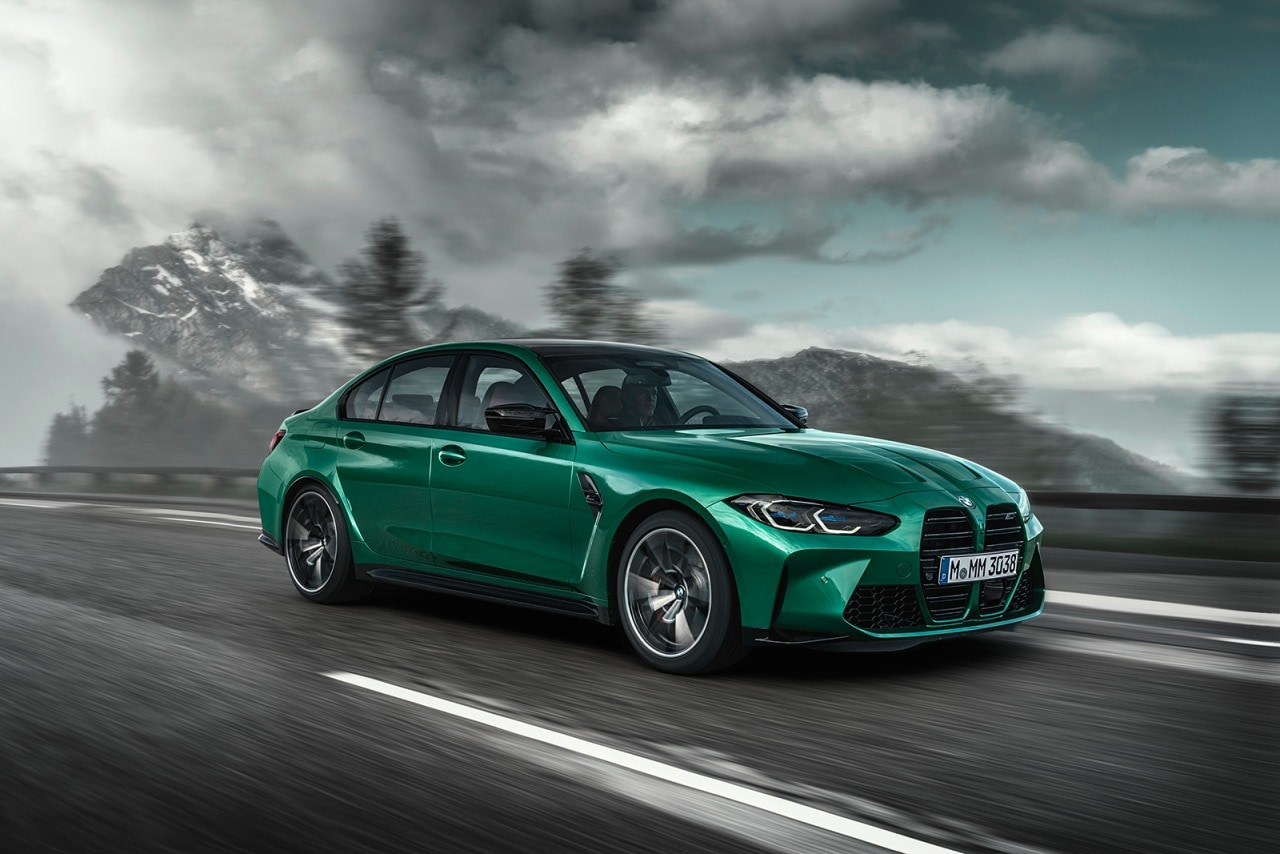These days, the lineup is split between M3 and M4. Both drive the same, but the M4 uses the 4 Series coupe body shell and the M3 is the four-door sedan. There's little functional or tuning difference between them otherwise.
Both have the controversial giant vertical kidney grille of the regular 4 Series coupe. It hasn't gone down well among internet commenters. But BMW knows its M3 buyers well and says it wanted to give them a car that looks different and aggressive. On that, we can certainly say BMW succeeded. And hey, if you hate the bucktooth look, you can just specify a dark body color to disguise the gaping black grille.
The regular M3's release date is set for March of 2021. The M3 Competition version will come out a few months later in summer 2021.
What's under the M3's hood?
Powering the standard M3 is a turbocharged 3.0-liter inline six-cylinder. This new S58 engine (BMW's name for it) is similar to the previous M3's engine (the S55) but has been given a thorough overhaul. It produces 473 horsepower and 406 lb-ft of torque, which is a bump of 48 hp over the previous model.
Stepping up to the M3 Competition costs an additional $2,900 and increases output to 503 hp and 479 lb-ft of torque. That's the one we tested. It's an engine with true competition engineering, closely related to the unit that BMW will use for its GT3 race car.
Alongside an eight-speed sport-tuned automatic transmission is a six-speed manual, which is a rarity for a high-performance car these days. The Competition model is automatic-only, giving the quickest acceleration times possible. Anyway, we hear that the more torque-y engine would endanger the manual box's health. Note the autobox is now a torque converter type, not the dual-clutch DCT automatic of the previous generation M3.
The M3 and M3 Competition are rear-wheel drive as standard, and again that was what our Competition tester had. But for the first time BMW will be adding all-wheel drive to the line. Snowbelt buyers have asked for it. But frankly, no matter the weather, getting over 500 horsepower through just two tires will always be a challenge. It's not just a regular AWD system. As with the M5, the AWD variants will have a rear-wheel-drive mode for purists with a generous budget for tires.
BMW puts the 0-60 mph time for the standard M3 at 4.1 seconds — likely a few ticks slower if you opt for the manual — and 3.8 seconds for the Competition. Top speed maxes out at 155 mph, though you can increase this to 180 mph with the optional M Driver's package.
Heat management is crucial given the M3's higher propensity for track use versus the standard 3 Series. The M3 adds larger intakes and several cooling systems, with the Competition model further benefitting from a transmission cooler. So those giant nostrils at the front aren't just there to scare passers-by. High lateral cornering loads are also expected, so the M3 gains a dual-sump oil system to ensure the engine is always well lubricated.
How does the M3 drive?
The Competition model is almost ridiculously rapid. Big speeds just ambush you. Any significant right-ankle extension has you riding ahead on a colossal wave of torque, and yet there are few sensations to alert you to what's going on. The engine note is a classical straight-six hum, a very different and perhaps less antisocial thing than the rambunctious V8 beats of the rival Mercedes-AMG C 63.
The accessible torque makes the M3 feel mighty. There's a little turbo lag below 3,000 rpm, but third and fourth gear give mighty thrust for real-road driving. From then on it's a smooth surge to the redline; the engine never loses enthusiasm for rocketing you forward. The main indication it's getting to the rev limit is an array of shift-up lights in the instrument pack and an optional head-up display.
The automatic transmission has a variable shift-speed. Even its gentlest setting is hardly sloppy, and the quicker ones are ultra fast. Plus its lock-up clutch operates keenly to give a solid feeling of connection from throttle pedal to engine to wheels.
The steering isn't twitchy, so highway driving is relaxing. On smooth roads and tracks, it's a blissfully accurate and confident machine. But uneven surfaces have the front end hunting left and right somewhat. Dive into a curve and the M3 responds immediately. This is a car that never wants to understeer; you can feel the car is working the rear tires. Add power and that sensation deepens. Then, after a moment, the active differential hooks up and stabilizes the car, letting you rocket away.
If you have the traction control on its looser setting, the new M3 lets go at the back much more progressively than the previous generation. Notably, the stability control system now has 10 different stages of control so you can dial in just the right amount of safety-net protection to balance out your hero driving antics.
The brakes have ample power and two response settings. Carbon ceramic brakes are optional for this new M3 and are probably worth the investment if you're planning to do a lot of high-performance track days.
How comfortable is the M3?
The suspension tuning is firm. At low urban speeds the M3 will register bumps up into the seats. But get a little speed going and the suspension begins to breathe. You always know it's extremely sporty, but the adaptive dampers take the harsh impacts off your progress.
The standard seats have considerable extra bolstering for cornering support. Should you want something splashier, the 2021 M3 has a new option for race-style carbon-fiber front bucket seats. They have trick-looking carbon-fiber shells and cutouts for five-point harnesses, and yet they still have electric adjustment for reach, height, tilt, recline and width. They're decently comfortable except for the bulge in the front-center seat cushion that forces you to splay your legs.
Wind noise is generally low. But a bigger issue is road noise. The tires roar harshly on all but the smoothest surfaces, and slap into transverse ridges as the surface changes. Find a section of smooth new asphalt and this is a car that cruises very quietly, the engine falling near-silent and the wind noise hushed. But on a concrete highway you'll have to turn the stereo up loud.
How's the M3's interior?
The M3's interior is similar in layout and design to its parent car, the current BMW 3 Series sedan. Everything is made of fine materials. Switch actions are good. To lift up the standard 3 Series cabin there's contrast stitching in the M colors of blue and red, plus alloy pieces, red buttons, different screen graphics and optional carbon-fiber decorative trim inserts. Multiple combinations of leather color are available, from somber black to wild blue with yellow accents. The available caramel-colored leather is a tasteful choice so long as you don't picture being trapped in millionaire's shortbread.
We're unconvinced by the instrument graphics. Switch to M mode and you get a mirror-image pair of tachometers. They're stubby, hard-to-read bar graphs. Why not just one big, clear, round one? Other than that, interior dimensions and comfort are very close to the standard 3 Series. It's a car that has grown a little since the previous generation, and there's enough rear legroom that average-height adults can sit in the back comfortably.
How's the M3's tech?
BMW's latest iDrive 7.0 software powers the new M3's infotainment system and remains one of the most intuitive interfaces in the class. The large 10.25-inch display dominates the upper dash, and the system can be controlled via touch or by using a traditional dial on the center console. To help further reduce distraction, a robust voice recognition system controls a variety of vehicle functions so the driver can keep both hands on the wheel. Apple CarPlay and Android Auto are standard, as are a suite of performance-focused apps and a navigation system. A large, detailed head-up display is optional.
A new M Drive Professional option should be a hit with track-day enthusiasts. It includes a built-in lap timer that shows up in the head-up and central displays and logs laps so you can store your best time. Telemetry from the various systems can be analyzed later through the BMW M Laptimer app for compatible iPhones.
Running counter to getting quick lap times — but equally entertaining — is the M Drift Analyzer. Yes, BMW of all companies has fitted a car that can record how well you power slide your car around a turn. The M Drift Analyzer records the duration, distance and angle of a drift and gives your results a star rating. Get five stars and, hey, you're a drift hero! Just one star? Dude, your drift sucked.
Besides having the typical advanced safety features onboard, the M3 adapts the traction and stability control systems for more customization. Opting for M Drive Professional includes M Traction Control, which lets drivers select between 10 levels of electronic intervention to suit their driving style and/or bravery. We're quite fond of a similar dial found in the Mercedes-AMG GT R. But if you're tempted to use it on the road instead of the track, it's the very opposite of a safety aid.
The following systems are controlled by two shortcut M buttons on the steering wheel: throttle sensitivity, transmission shift time, adaptive damper firmness, steering weight, brake pedal sensitivity, stability systems and low-rev exhaust sound. The idea is you have three favourite setups: default, plus M1 and M2. You set your parameters for M1 and M2 using a submenu. But too much choice can be a distraction. Every time an interesting road opens up, you fear you've selected the wrong mode, or want to try another, rather than just sitting back and enjoying the drive. Truth is, an M3 is great in any mode.
How's the M3's storage?
It's much like the regular 3 Series sedan with the expected array of storage bins and cupholders. The trunk holds 13 cubic feet of stuff, and you can expand the area by folding down the rear 40/20/40-split seat sections. The carbon-fiber sport seats have no back pockets.
Edmunds says
A new engine, transmission, body and technology: This is a major upgrade for the M3. It's drastically fast, yet it inspires confidence when approaching its limits, which are both improvements over the old model. This is undeniably an entertaining and engaging high-performance sedan.
That said, it also has a lot of tire noise and harshness, firm suspension tuning, and doesn't trickle in traffic like a regular BMW. If you just want a fairly quick BMW sedan that's already pretty involving, stop at the M340i. The M3 does extract a price for its abilities, and it isn't just monetary.





 by
by